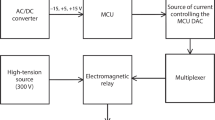Abstract
A new type of electrophrenic respirator has been developed, which synchronously stimulates the phrenic nerve with the correct impulses. Common-mode artefacts such as the e.c.g., e.m.g., and 50 Hz are suppressed by means of a low-noise differential amplifier with high common-mode rejection and a high-input impedance. Differential-mode artefacts from bipolar electrodes are eliminated by means of band-pass filters and logic circuits, which have been designed with the aid of the characteristics of the phrenic nerve impulses. By this method, the nerve impulses can be picked up without damaging the phrenic nerve trunk. An alternating bidirectional voltage is used for the nerve stimulation to obtain a natural breathing action. This respirator has the possibilities of curing central hypoventilation without disturbance of the respiratory feedback system.
Sommaire
On a développé un nouveau type de respirateur électrophrénique pour effectuer la stimulation synchrone du nerf phrénique avec les impulsions correctes. Les artéfacts de mode commun tels que l'ECG, l'EMG et les 50 Hz sont supprimés par un amplificateur différentiel ayant un taux élevé de réjection du mode commun et une forte impédance d'entrée. Des artéfacts à mode différentiel partant d'électrodes bipolaires sont éliminés par des filtres passe-haut et des circuits de logique étudiés å l'aide des caractéristiques des impulsions du nerf phrénique. Cette méthode permet de capter les impulsions du nerf sans endommager le tronc du nerf phrénique. Une tension alternative bidirectionnelle sert à stimuler le nerf afin d'obtenir une respiration naturelle. Le respirateur est capable de guérir l'hypoventilation centrale sans perturber le système de réaction respiratoire.
Zusammenfassung
Es wurde ein neues elektrisches Atemgerät zur Beatmung des Zwerchfells entwickelt, das den Zwerchfellnerv synchron mit den richtigen Impulsen stimuliert. Gleichtaktartefakte wie EKG, EMG und 50 Hz werden durch einen Differenzverstärker mit niedrigem Störpegel, mit starker Gleichtaktunterdrückung und hoher Eingangsimpedanz unterdrückt. Differentialtakt-Artefakte von zweipoligen Elektroden werden durch Bandpaßfilter und logische Schaltungen ausgeschaltet, die mit Hilfe der Merkmale von Zwerchfell-Nervenimpulsen konstruiert wurden. Durch dieses Verfahren können die Nervenimpulse ohne Beschädigung des Zwerchfell-Nervenstranges übernommen werden. Zur Stimulierung des Nervs wird eine zweiseitig gerichtete Spannung verwendet, um eine natürliche Atmungswirkung zu erzielen. Dieses Atemgerät hat die Möglichkeit, eine zentrale Unterbeatmung ohne Störung der Rückkoppelung für die Atmung zu beheben.
Similar content being viewed by others
References
Bilgutay, A. M., Bilgutay, I. M., Garamella, J. J., Jensen, N. K., Schmidt, W. R., Lymch, M. F. andKelly, W. D. (1970) Augmented ventilation by synchronous phrenic nerve stimulation.Trans. Am. Soc. Artif. Int. Organs 16, 213–217.
Comroe, J. H. (1974) Physiology of respiration.Year Book Medical Publishers Inc. USA.
Daggett, W. M., Shanahan, E. A., Kazemi, H., Morgan, A. P. andAusten, W. G. (1970) Intracaval electrophrenic stimulation. II. Studies on pulmonary mechanics, surface tension, urine flow, and bilateral phrenic nerve stimulation.J. Thorac. Cardiovasc. Surg.,60, 98–107.
De Villiers R., Nose, Y., Meier, W. andKantrowitz, A. (1964) Long-term continuous electrostimulation of a peripheral nerve.Trans. Am. Soc. Artif. Int. Organs 10, 357–365.
Furman, S., Koerner, S. K., Escher, D. J. W., Rapowitz, A. J., Benjamin, J. andTarjan, P. (1971) Transvenous stimulation of the phrenic nerves.J. Thorac. Cardiovasc. Surg. 62, 743–751.
Glenn, W. W. L., Hageman, J. H. Mauro, A., Eisenberg, L., Flanigan, S. andHarvard, M. (1964) Electrical stimulation of exitable tissue by radio-frequency transmission.Ann. Surg. 160, 338–350.
Glenn, W. W. L., Holcomb, W. G., Gee, J. B. L. andRath, R. (1970) Central hypoventilation: long-term ventilatory assistance by radiofrequency electrophrenic respiration.Ann. Surg. 172, 755–773.
Handa, Y., Natori, N., Sato, G., Hoshimiya, N., Takahashi, M., Matsuo, T., Nitta, S., Ohkuda, K. andNakada, T. (1976) Basic studies on electrophrenic respiration (Part 2) Assisted ventilation by the synchronous electrophrenic respirator.Med. & Biol. Engng. 14, (4), 395–401.
Hoshimiya, N., Takahashi, M., Handa, Y. andSato, G. (1973) Electrophrenic respirator synchronized with phrenic nerve impulses.Japan. J. Med. Electron. & Biol. Engng. 11, 173–179.
Ikeda, K., Noshiro, M. andSuzuki, S. (1974) Analysis of synchronization phenomena of respiratory rhythm through electrical stimulation of the phrenic nerve.Japan. J. Med. Electron. & Biol. Engng. 12, 372–380.
Ito, M. andOkuda, T. (1971) Application of collagen to medical electronics: Collagen electrode.Japan. J. Med. Electron. & Biol. Engng. 9, 355–358.
Johnson, V. andEiseman, B. (1971) Reinforcement of ventilation with electrophrenic pacing of the paralyzed diaphragm.J. Thorac. Cardiovasc. Surg. 62, 651–657.
Mitamura, Y., Mikami, T., Sugawara, H. andYoshimoto, C. (1971) An optimally controlled respirator.IEEE Trans. BME-18, 330–338.
Sarnoff, S. J., Hardenbergh, E. andWhittenberger, J. L. (1948) Electrophrenic respiration.Am. J. Physiol. 155, 1–9.
Sato, G., Glenn, W. W. L., Holcomb, W. G. andWuench, D. (1970) Further experience with electrical stimulation of the phrenic nerve: Electrically induced fatigue.Surgery 68, 817–826.
Staubitz, W. J., Cheng, S. F., Gillen, H. W., Holmquist, B., Zurlo, P. andGreatbatch, W. (1966) Management of neurogenic bladder in paraplegic dogs by electrical stimulation of pelvic nerves.Inv. Urology 4, 20–29.
Stemmer, E. A., Crawford, D. W., List, J. W., Heber, R. E. andConnolly, J. E. (1967) Diaphragmatic pacing in the treatment of hypoventilation syndrome.J. Thorac. Cardiovasc. Surg. 54, 649–657.
Waud, R. A. (1937) Production of artificial respiration by rhythmic stimulation of the phrenic nerves.Nature 140, 849.
Author information
Authors and Affiliations
Rights and permissions
About this article
Cite this article
Hoshimiya, N., Takahashi, M., Handa, Y. et al. Basic studies on electrophrenic respiration Part 1—Electrophrenic respirator synchronised with phrenic nerve impulses. Med. & biol. Engng. 14, 387–394 (1976). https://doi.org/10.1007/BF02476115
Received:
Accepted:
Issue Date:
DOI: https://doi.org/10.1007/BF02476115




